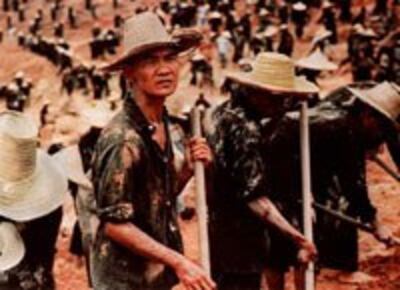Eighth in a series

For a brief period in 1970, I had the privilege of working in wartime Cambodia with Dith Pran, who became famous as the New York Times interpreter who survived the Khmer Rouge and became the key figure in the movie “The Killing Fields.”
After reaching the United States, Pran became a photographer for The Times and started a center to teach people about the Khmer Rouge genocide.
He was the best interpreter and “fixer” with whom I worked in Cambodia. I remember him for his cheerfulness in spite of adversity, a quality that goes a long way in the middle of a war.
I was so impressed with Pran that I included some of his comments in a story that I wrote for The Christian Science Monitor.
It was during the first year of the five-year Cambodian War. Pran, 27 years old at the time, still hoped that his countrymen could prevail against seasoned North Vietnamese and Viet Cong troops. My story, dated Dec. 16, 1970, describes a road trip we took together through war-battered towns and villages north of Phnom Penh. Dith Pran died on March 30 at the age of 65.
Reprinted with permission of the Christian Science Monitor:
Cambodians: ‘We are united’
By Daniel Southerland, Special correspondent
The Christian Science Monitor Christian Science Monitor Dec 16, 1970
While Americans debate whether Cambodia could become “another Vietnam,” one’s thoughts flash back to what a few Cambodians said on the subject several weeks ago.
We were traveling by car to Taing Kauk, the village where the Cambodian Army was stalled in its northward drive.
Our Cambodian interpreter, Dith Pran, a thin, friendly youth, used to guide tourists through the ancient ruins of Angkor. Now he guides journalists through the modern ruins of places like Skoun and Taing Kauk. His own home in Siem Reap, next to Angkor, has joined Cambodia’s new ruins. It was destroyed in fighting between the Cambodian Army and the North Vietnamese and Viet Cong.
“This is not a civil war like the Vietnam war,” Dith Pran was saying as we neared the Tonle Sap ferry crossing. “This is a war of aggression.”
Unity Stressed
“If we can get the right aid, we can win, because we Khmers are united as one block,” he said cheerfully. “We’re not divided like the Vietnamese.”
“We don’t want foreign troops here,” he said, but added that South Vietnamese troops would probably be needed a while longer in Cambodia, disliked though they were as ancient enemies.
On the battered outskirts of Skoun, we picked up two hitchhikers, both former schoolteachers, now, like so many others, with the Army. They were returning to Taing Kauk to see what was left of their homes now that the North Vietnamese and Viet Cong had been driven out.
The first sights of Taing Kauk were not encouraging. Air strikes and artillery had bashed in the roof and walls of the school building which served as a Viet Cong headquarters.
Then we saw the home of Mam Saath, one of the teachers. Just a few pillars were left, standing in a pile of rubble. Not surprised at the loss of his home, Mam Saath and the other teacher left us then, smiling, bowing politely, thanking us for the ride.
Monks invited us to spend the night in Taing Kauk’s main Buddhist pagoda. It was particularly recommended by one and all, because its thick walls were good protection against mortar attack, and Taing Kauk was taking mortar fire almost every night at the time.
In the pagoda, two Cambodian civilian physicians, now attached to the Army, offered us a meal of American C rations purchased on the black market in Phnom Penh.
‘This is different’
“The American people think this is a civil war, don’t they?” said one of the doctors, opening an olive-green can of ham. He spoke French.
“But perhaps they’re beginning to understand, aren’t they?” he asked, a worried look on his face.
“This is different from the war in Vietnam,” he said.
The two physicians worked at the Soviet-built hospital in Phnom Penh, known as the Khmer-Soviet Friendship Hospital. They told how the Russian physicians at the hospital refused to treat the war wounded who were arriving there with increasing frequency.
‘Now we know’
“In the past, we made a mistake about who our real friends were,” said one of the uniformed physicians, referring to the Sihanouk era of good relations with the Soviet Union. “Now we know who our friends are.”
The two Cambodians expressed the hope that the United States would become a true friend. They agreed that Vice-President Spiro T. Agnew’s visit to Phnom Penh in August was “symbolic” of American support for the Lon Nol government. Still, they seemed uncertain about how far the U.S. Government would go in helping them.
It was dark now, and overhead a heavily armed South Vietnamese Air Force plane took up its vigil, flying lazy circles, its lights blinking, providing protection for the Cambodian troops below.
Plane reassuring
The visiting newspaper reporter remarked that it was comforting to hear the sound of the Vietnamese plane overhead. It would be nice to have around in case of an attack.
“We don’t put much trust in the Vietnamese,” said one of the doctors, his voice suddenly grown cool.
“But the Vietnamese do have some good pilots,” said the reporter.
“Yes, and we could have good pilots, too, if somebody would train them,” the Cambodian said, his voice rising sharply.
"If only we had our own tanks and helicopters…,” said the other doctor.
I later learned that the South Vietnamese plane which had been flying overhead that night was shot down the next day. No one seemed to know, or care, if there were any survivors among the plane’s crew — men so needed, yet so detested, by the Cambodians they were supposed to protect.
Reprinted with permission of the Christian Science Monitor:
